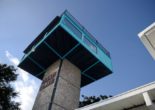The Revolution Will Not Be Painterly
On March 8, 2026, I received an email from the Texas art blog GlassTire with the subject header “Should Artists Be Revolutionaries Right Now?” It points to an article by Christina Rees about San Antonio painter Vincent Valdez, who is working on a large painting depicting a family of KKK people that was written up in The New York Times just a few days before Rees’s GlassTire piece. Unlike the Times’ piece, which describes Valdez’s painting and links it to Donald Trump’s problems with overt white supremacy, Rees’s article, titled “Something’s in the Water,” reads like a call to action.
“Now isn’t the time to navel gaze or decorate,” Rees writes. “Artists and musicians and writers and filmmakers have always been good at sounding the alarm. I’d sure like to see more of it right here at home…Artists would do well,” she concludes, “to tap their inner revolutionary.”
Now, I’m one of those people who believes that everything is political — nothing is not-political — but a painting, made for the commercial gallery context, ie. “the art world”…? Give me a break! Let’s face it, the marketplace of commercial art galleries is a luxury goods market. The people who have tens, if not hundreds of thousands and more, to spend on contemporary art are the 1%, not the people on the losing end of “politics.” Sure, it is possible that some students and academics might view these works for free while they are on display (i.e. up for sale) in a commercial gallery, but that number of people is small and the time frame these works are on view is limited. And yes, some such works may indeed be purchased by or gifted to or loaned to museums (tax write-off!) where a broader segment of the public may see them, but that number of people is also limited. For the most part, these are precious objects which will spend the bulk of their lives hanging on the walls of private homes and corporate boardrooms — amid the clinking champagne flutes and full-throated laughter of the bosses of the world, not the world’s most wretched.

Vincent Valdez in his San Antonio studio. Photo by Michael Stravato for The New York Times.

Abilify by Alpin Arda Bağcık, oil on canvas, 200 x 140 cm, courtesy of Galeri Zilberman.
On a side note, what does it mean that, while in Istanbul last May, I stumbled upon the Turkish painter Alpin Arda Bağcık, who makes paintings of (in)famous scenes from world history, including US history, that aren’t all that different, in subject matter, at least, from Vincent Valdez’s painting The City? And is Alpin Arda Bağcık guilty of cultural appropriation or what?
All art is inherently political. Some forms — such as books and prints and murals, which can be reproduced and cheaply distributed or otherwise accessed and appreciated by masses of people — are more democratic than others — such as painting, in which value is derived at least partly from rarity. Some forms, perhaps the most powerful and insidious forms, aren’t even called “art” or the “propaganda” that they are — they are called “advertising.” Still, I think Rees is on to something, at least with her title, “Something’s in the Water.” Indeed, these times of ours do seem more turbulent than usual, and many writers are asking questions such as hers. The New York Times convened a panel to raise the question “Is Our Art Equal to the Challenges of Our Times?” in November 2026. The Nation magazine devoted a good chunk of its January 2026 issue to How the Creative Response of Artists and Activists Can Transform the World. London’s The Guardian devoted a whole series in 2026 to “Can Fiction Change Our View of Oil?” and even Free Press Houston published a piece on “Building a Social Movements Through Arts Organizing” a little over a year ago.
And that’s just in publishing. Meanwhile, among (non-commercial) art institutions, “social practices” (also called “relational aesthetics”), have been gaining popularity. The major US arts funding institution Creative Capital is hosting a professional development seminar on “us[ing] your creative practice to organize communities, speak truth to power, and make more engaging and impactful artworks.” The City College of New York and New York University recently teamed up on a symposium on Art, Social Change, and the Urban Sphere. The Robert Ruaschenberg Foundation offers an Artist as Activist Fellowship for people “who address important global challenges through their creative practice.” Portland State University in Oregon has started offering a Master of Fine Arts degree in social practices. Locally, in Houston, the Houston Center for Photography hosted a panel on “The Value of Art to Healing and Social Connectedness,” and the University of Houston hosted a “poets on politics” event right before the 2026 election.
But if social practices is the subject, then there’s no better example anywhere than Project Row Houses. The current round of installations, Shattering the Concrete: Artists, Activists and Instigators, at Project Row Houses “explor[es] the role that art can play in challenging our current political paradigm and fomenting political change.”

We presume, when we walk into a science museum, that we are being shown science, and that science, unlike the humanities, is objective, is not subject to human frailties, such as political whimsy. We presume wrong. Instead, we walk into a museum and we are awestruck by the sublime — the towering skeleton of a dinosaur, the dazzling sparkle of gemstones — and in this vulnerable, trusting state of open-mindedness, we are subjected to oil and gas industry propaganda.
A recent New York Times article discusses budget cuts at science museums across the country. To stay afloat, some museums are moving away from science, or cozying up to corporate sponsors in ways that seem suspect. “The pandering can be insidious, too,” writes Richard Conniff. “The Perot Museum of Nature and Science in Dallas, which treats visitors to a virtual ride down a hydraulic fracturing well, recently made headlines for avoiding explicit references to climate change. Other museums omit scientific information on evolution. ‘We don’t need people to come in here and reject us,’ Carolyn Sumners, a vice president at the Houston Museum of Natural Science, explained to The Dallas Morning News.”
Did you get that? A vice president at the Houston Museum of Natural Science would rather reject science than be “rejected” by an ignorant public.

Photo by Alex Barber, courtesy of Project Row Houses.
Not an Alternative reproduces the “sponsorship wall” from the Houston Museum of Natural Science to remind viewers who is funding this “science,” only on they have made the relative size of the names indicative of the corporations’ greenhouse gas emissions, rather than the size of their monetary contribution, as at the museum. Their docent wears an ExxonMobil shirt. To the right, behind the glass, viewers can see a reproduction of a coastal wetlands installation taken directly from the HMNS — only this piece includes what the oil companies don’t want viewers to see.
Mining the HMNS includes charts, maps, infographics, and even holograms to tell ugly stories about the oil and gas industry that the HMNS so casually, unconscionably omits, but they don’t leave it at that. Like any good science museum, Mining the HMNS is conducting new research of its own. It has outfitted an army of dinosaurs (see the featured image at the top of the page, by Alex Barber) with air quality monitors that have been deployed across the east side of Houston, around the Houston Ship Channel, which is “the largest concentration of petroleum refineries, petrochemical companies, and storage structures on Earth.” Additionally, they are offering monthly “Toxic Tours” of these areas on the first Saturday of every month (May 7 and June 4 remaining) — RSVP here.

Photo by Alex Barber, courtesy of Project Row Houses.
The Argus Project takes its name “from the Greek myth of Argus, the giant with 100 eyes who was a watchman both for and against the gods,” asking “If police need to wear body armor to protect themselves while in public, what does The Public need to wear to protect themselves from the police?” At the center of this installation is “a suit of counter-surveillance body armor…equipped with 15 body cameras that surveil the police.” A video projection shows people using their cell phone cameras to document police abuses, as H-Town Copwatch does, and a series of programs will educate people on topics such as Know Your Rights and filming police as a check to abuse of power and to hold police accountable.
Here are some photos from my new neighborhood in the South Bronx, just across the East River from Harlem, the stomping grounds of The Argus Project.
These bright lights and the generators that power them run all night, every night, with the panopticon towering above the intersection, windows blacked out so nobody can tell where the cops are looking or even there is in fact a cop or cops inside. The light and the sound, especially, though, are so obnoxious and disrespectful in their presumption of guilt.

Photo by Alex Barber, courtesy of PRH.

Photo by Alex Barber, courtesy of PRH.
Along similar lines, the People’s Paper Co-op “appropriates erasure as a means to defy a flawed system.” An initiative of of the Philadelphia-based Village of Arts and Humanities, PPC “organizes free expungement clinics where participants work with lawyers to legally transform their criminal records, then take printouts of their records, tear them up, and transform them into new blank sheets of homemade paper.”

Photo by Alex Barber, courtesy of PRH.
These blank sheets of paper are then decorated with the hopes and dreams of the participants who have now been freed from this baggage of who the state says they used to be, with their answer to the prompt, “When people look at your criminal record what about you as a human being do they not see?” (Full disclosure: I wish I was around to benefit from one of these workshops, because I am one of the 70 million+ people living with a criminal record in the USA.)
Taking a slightly less confrontational approach to politics, the Karankawa installation by Nuria Montiel and John Pluecker is something of a “performative statement,” an utterance, such as “Let there be light” and “I now pronounce you man and wife,” that, by its very utterance, does not just describe reality but changes reality. In this case, by calling attention to the existence of the First Nations people who inhabited the area we now call Houston and environs, the Karankawa, the pair, along with their collaborator Lucas Gorham (who claims Karankawa ancestry), assert “We are,” and as Jennifer Fox Bennett asserted in these pages some years ago, they want to emphasize that this is a living culture — its practitioners live among us, as our friends and neighbors — it is not some distant memory, penned off in some museum diorama.

Photo by Alex Barber, courtesy of PRH.
The hybrid theater group from Tucson, Verbo•bala, has created the installation Acordarnos (remember us), which uses charts, graphs, testimony, string, photographs, and icons to remind of the harsh brutality of the man made border along the US and Mexico.

Photo by Alex Barber, courtesy of PRH.

Photo by Alex Barber, courtesy of PRH.

Photo by Alex Barber, courtesy of PRH.

Photo by Alex Barber, courtesy of PRH.
Finally, Storyline Media from Brooklyn posits a future where the 28th Amendment to the Constitution of the United States of America guarantees adequate housing for all its citizens, thus begging the question, “What’s next?”

Photo by Alex Barber, courtesy of PRH.
And Houston’s own Carrie Schneider and Jennie Ash, through their ongoing artists advocacy project Charge have created something like a union hall for creative professionals where they will be organizing conversations as they organize people.

Photo by Alex Barber, courtesy of PRH.
Round 44, Shattering the Concrete: Artists, Activists and Instigators runs through June 19 at Project Row Houses.
















